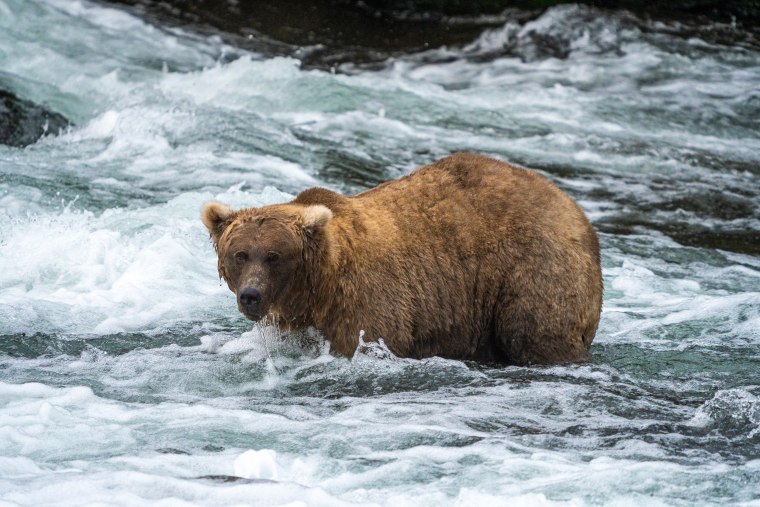A dominant mother bear in Alaska’s Katmai National Park and Preserve has been crowned Fat Bear Week’s queen of corpulence.
Bear 128, nicknamed Grazer, got 108,321 votes in the final bracket of Fat Bear Week, an annual competition that draws hundreds of thousands of internet users to decide who in Katmai is the fattest of the fat.
This year, 1.4 million votes were cast from 100 countries, staff members at Katmai said.
Grazer, an adult who stayed single this season, beat Chunk by 85,187 votes, proving 2023 is the year of the sow.
“The gutsy girl grounded the guy with a gut. 32 Chunk, proved his prominent posterior was worthy of a whopping win. But in the end, Chunk got Grazered,” Katmai National Park wrote on X. “Let’s crown our Queen that’s thicker than a bowl of oatmeal, 128 Grazer!”
 Bear 128, nicknamed Grazer, on Sept. 14.F. Jimenez / Katmai National Park and Preserve
Bear 128, nicknamed Grazer, on Sept. 14.F. Jimenez / Katmai National Park and Preserve
Grazer, an 18-year-old with blond ears and light brown fur, is renowned for her dominance, so much so that even the most alpha male bears on the river give her a wide berth.
“Grazer is best known on the river as a very protective and defensive mother bear,” said Naomi Boak, a media ranger at Katmai. “When Grazer has cubs, watch out. She will attack the largest, most dominant bears on the river.”
Grazer raised two litters and is one of the best salmon fishers on the river, the park’s website says. She was introduced to Brooks River as a cub in 2005 and spends her days fishing in the pools of Brooks Falls, a 6-foot waterfall. The river is populated by rainbow trout, arctic char and salmon.
Boak, who photographs and livestreams the bears during the competition, estimates that Grazer is well over 700 or 800 pounds.
The biggest boars, like runner-up Chunk, are well over 1,200 pounds. Chunk, 18, is one of the three most dominant bears on the river, Boak said.
Fat is essential for female bears: More weight means more cubs, she said. But when female bears aren’t caring for cubs, they can dedicate themselves to self-care and feeding, she said.
“How great is it that when you’re single, you can just get fat and succeed? Is there anything better?” Boak said. She thinks Grazer succeeded this year because stories about the challenges of mother bears have resonated with people.
The bears of Katmai are preparing to hibernate from late October until March or April. Their bodies go into a state of hyperphasia, which means the hormone that tells them they are full stops working, Boak said.
Fat Bear Week started when Mike Fitz, the resident naturalist for explore.org, decided that there should be a Fat Bear Tuesday to celebrate the bears at Katmai as they gain weight, Boak said. It was so successful that Fitz decided to turn the day into a weeklong bracketed competition the next year, in 2015.
 Bear 128, nicknamed Grazer, on Sept. 14.F. Jimenez / Katmai National Park and Preserve
Bear 128, nicknamed Grazer, on Sept. 14.F. Jimenez / Katmai National Park and Preserve
Although Brooks Camp, the bears’ habitat, is remote and inaccessible by road, 10 million people tuned in to the “bear cams” on explore.org last year, she said. The bear cams livestream from seven locations around Brooks Falls.
A 2019 survey of viewers of the Katmai bear cams revealed that those who could identify individual bears were much more likely to support conservation programs.
“When you watch the bear cams, you’re watching five soap operas a day,” Boak said. “Will Grazer come back with cubs? Will the big boars have to keep an eye out for her?”
To enter the Fat Bear Week bracket, bears need to show up in the spring while they are skinny, then come back in the fall when they are fattening up, she said.
“The females look smaller and skinnier at the beginning of the season than the male bears do,” said Boak, who thinks the contrast is one of the reasons Grazer won this year.
Natalie Kainz
Natalie Kainz is a news associate for NBC News.
>>> Read full article>>>
Copyright for syndicated content belongs to the linked Source : NBC News – https://www.nbcnews.com/news/animal-news/single-mother-thicker-bowl-oatmeal-wins-alaskas-fat-bear-week-rcna120149































